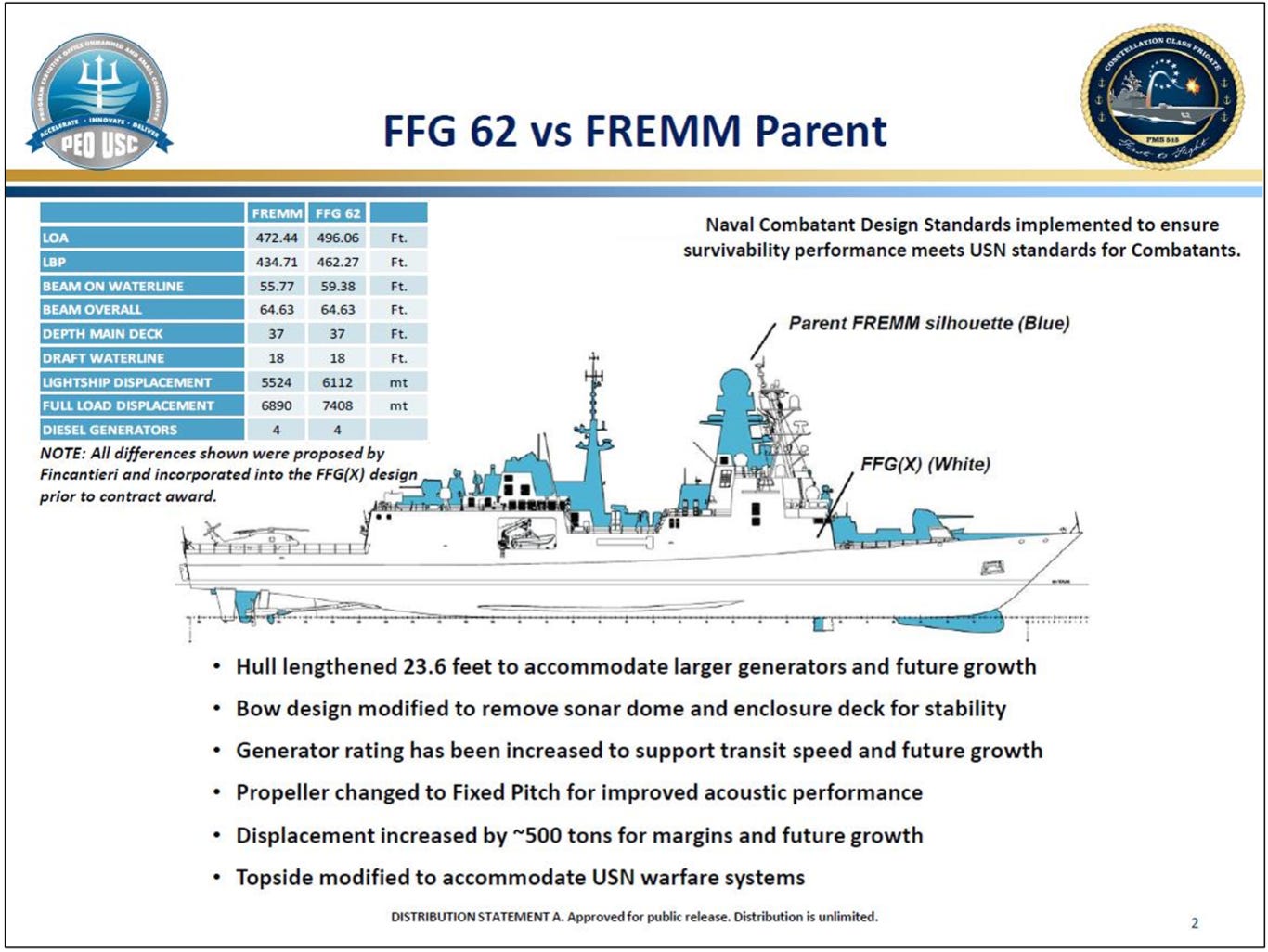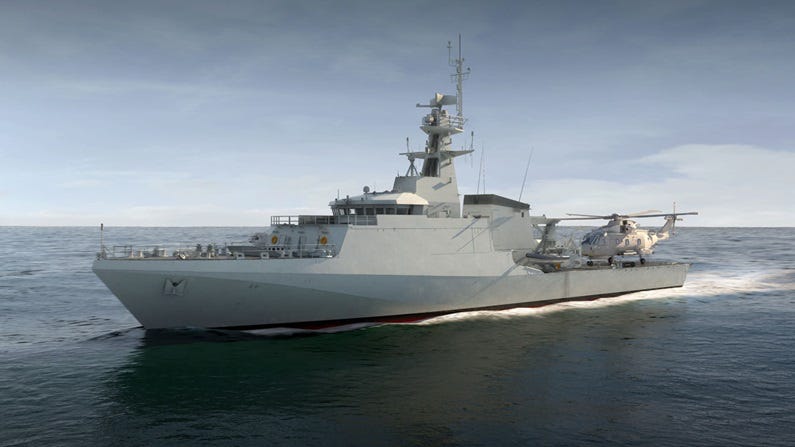DDG to FFG to OPV: Small Ships, Big Sticks, & Scaled Escalation
...yes, you can have it all ... or some of all ... maybe
Over the holiday weekend, I had the pleasure to contribute to a great X Spaces hosted by John Konrad of gCaptain. We mostly discussed the events in the Red Sea, and the people John pulled in addressed the issue from a variety of angles.
From the Navy side of the house, one of the things we discussed was how for this mission it appears that our Arleigh Burke DDG are the high-demand/low-density unit no one can seem to get enough of.
It’s natural, really. She’s a well designed multi-mission platform that has enough flexibility to perform a whole host of mission areas. In answering a question towards the end, I made a comment that wasn’t fully fleshed out.
At about the 1:42 mark of the X Spaces, Trent Telenko as a question where we discussed the new Constellation Class FFG building right now. As regulars know, I’ve been pro-FREMM before we even had a FFG(X) program. Trent has a concern about the lack of AAW armament in the MK-41 VLS. I was not clear in my response, so to be clear here for the record, yes the Uncle Sam’s FREMM will have MK-41 VLS, but they will not have the capability of the MK-41 VLS you have on the Burkes. We are still trying to figure out the Standard Missile capability & loadout - and possibly TLAM - of Constellation, but the engineers will have to work that out by Hull-2 because Congress is making them.
This whole problem is, once again, with our acquisition process that is mostly concerned with their internal … whatever they do … as opposed to producing the best warship to meet a need. We can get to where we need to be, eventually, but to start the ball rolling we have to outsource the process to Rube Goldberg.
Of course, I would really prefer that part of a Flight II FFG that would include a 5” gun as well … but all in due time. I’ll take the FFG we can get right now so we can work to modify it into the FFG we need.
Looking at the lessons of the last few months about requirements for an escort ship, what we do know is that at least Hull-1 of the Constellation Class will not be able to do the escort requirements solo that Arleigh Burkes are being asked to do in the face of ASCM, ASBM, and the low end “flying lawnmower” type attack drones.
While I’m in favor of a more robust post-Transformationalist Constellation Class in its yet to be programed Flight II, that does not mean I do not support the “low-end” and smaller ships. Just the opposite. We need lower-end to do certain sets of missions so larger ships can better execute the missions they were designed to do.
A capability gap the US Navy has - and no, the USCG should not have this mission - is best represented by the offshore patrol vessel (OPV) such as HMS Trent (P224) - sadly not named for our questioner above.
Sir Humphrey over at Thin Pinstriped Line, does a real great job outlining the utility of this class of warship.
Amid the sabre rattling by Venezuela, the UK has taken the decision to engage in a port visit to Guyana by HMS TRENT. While the visit is not formally to do with the dispute, it is remarkably useful timing to have it occur as a very visible symbol of British support. Naturally the Venezuelan regime has responded with anger to this news, condemning the visit outright.
Port visits are a very powerful diplomatic tool when used well.
…
The reason that TRENT was the right ship for the job is because of her size and capability. Send too big a ship on a port visit and it will look visually impressive, but be of limited relevance to the host nation – Guyana has a very small coastguard, the flagship was the former RN RIVER class MCMV HMS ORWELL, but she is now reportedly unserviceable. If the RN sent a Type 45 to visit, the scale of the vessel and her capabilities would be far beyond anything the GDF operates, making joint training of limited value. By contrast, sending a smaller ship at the same rough level of capability as the Guyanan Coast Guard is far more valuable – training can be relevant and appropriate, for example joint manoeuvres or practising coast guard style drills. There is far more value in working at the same level than in leaving your hosts impressed but unable to take meaningful lessons from the experience. By working in partnership, you set the stage for future visits that will take the defence relationship to the next level.
Yes, you are hearing echos from Jerry Hendrix’s 2009 Fords Not Ferraris.
…people seem obsessed with wanting to make an OPV a frigate without giving any thought to the very different design philosophies that these ship classes have. A frigate is designed to go to war and fight in a very high intensity conflict and survive, with an extensive array of weapons and sensors and sufficient crew to carry out damage control if hit. An OPV is a grey hull, but has a far more austere fit of sensors and weapons and isn’t designed or intended to go to war in a serious way – and before you assume this is Treasury and MOD parsimony at play, in fact just about every nation that operates frigates and OPV’s uses them in this way – cheap, expendable and not intended to be in the way when missiles start getting thrown about. They are the ‘third rate’ vessels of the Napoleonic navy in modern form – intended to fly a flag, do the 99% of maritime work that doesn’t involve fighting in a war and doing it cheaply and efficiently. The RIVER class are the latest in a long line of proud RN units designed to be simple and highly effective – they may not have much in weapons, but this is an irrelevance for they are perhaps the most high value defence engagement platforms in the RN today.
Give it a full read. Great stuff.
So yes, two things can be true at once.
The events of the last few months in the Red Sea are sending a clear signal that if we wish to have our Constellation FFG perform the escort mission in the 21st Century - she needs to up her AAW game a bit. Just like a WWII DE did not have to have the bite of a DD, she needed just part of the bite - so too our FFG do not have to have the same bite as a DDG, but a fair fraction of it. Make no mistake, she will be needed to do the full breadth of missions because she will be there, just like DE 413 and her sisters were off Samar.
The USN really needs the OPV capability. Having them would better balance our fleet so they can execute those missions we don’t have the spare capacity to send our over-loved DDGs … and soon FFGs to do.






Couldn’t agree more. The River class are doing amazing work for the RN in Asia, incredibly well received.
I'm just shaking my head here...because it's been a well-known fact for 40 years or so that ship steel is cheap. A modern warship, much like a modern combat aircraft, is a truck for sensors and weapons. And it is those sensors and weapons, plus the software that knits them together, that drives the cost.
Taking a foreign hull, modifying it, and then substituting American sensors and weapons doesn't save a damned dime. The Constellation program will probably work - it will deliver ships that have actual fighting power - but I remain convinced it will not be cost-effective. Half the fighting power of a Burke, for three-quarters of the price. We would probably have done better to gone with a new-build Perry hull with updated sensors and weapons.
Now, as for an OPC...frankly, THAT is what LCS should have been. Not the mismash of "good ideas", nouveau jeune ecole fantasies, and out-of-control desirements we got. A simple hull, about 30 kts, 5 inch gun on the front end, helo and pad aft, and a SeaRAM amidships. If I'm going to FIGHT in the littorals, the smart move is to do it with airpower. But aircraft can't do stop-and-search missions, don't provide gunfire support, and don't have the presence of a gray hull with an American flag. Had we gone down that route, the program would have been a smashing success.